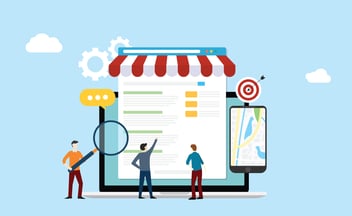How to Minimize Asset Expenses When Growing a Business
When looking at how successful a company is, one of the measures taken into consideration is its Return on Total Assets, ROTA for short.
This metric becomes all the more important as a company grows and scales, during which time it might be experiencing a cash flow crunch and feeling the need to save as much as possible to weather this critical period.
Just as you want to maximize the return you get from your assets, you also want to minimize the costs associated with them. After all, every penny saved is a penny that goes into your pocket and fattens your bottom line.

This is not to mention that minimizing costs of any kind is bound to increase your ROTA—and your peace of mind knowing that your business is functioning at its fullest capacity.
In this article, we’ll look at some ways to cut asset expenses while growing your business.
5 Ways to Reduce Asset Expenses
When it comes to reducing assets expenses, you will first need to know the current state of your business before you can look for improvement opportunities. Here are five best practices you can follow during your optimization process
1. Start by Making Smart and Strategic Decisions
As obvious as this may seem, there are several areas where business owners inadvertently make poor decisions that end up ruining them.
Making smart decisions in marketing
Marketing can be tricky, especially when a company is expanding and starting to serve a new niche.
There is always plenty of experimentation involved initially as the company won’t be yet aware of what works and what doesn’t. Also, growing companies are liable to change their identities, which will affect both a company’s branding and the impact of their messaging.
One way to reduce expenses is to adopt a unified marketing approach, such as the Business GrowthStack.
The Business GrowthStack is a holistic approach that ensures that each action in it drives the consumers towards the same decision. This strategy is built on four main pillars: sending clear messages, automating marketing, automating sales, and relying on well-planned campaigns.
This ensures that, as your business grows, you can more easily target new customers without risking losing the trust of the clients that helped you grow in the first place. And on top of that, you won’t be wasting time, money, and valuable business assets on campaigns that don’t yield the desired results.
Making smart financial decisions
When companies are growing, they might choose to take on debt to deal with their rising expenses.
With that said, it is worth mentioning that not all debt is created equal. One continuous expense that can eat into a company’s profit margin is the interest on the loans. Therefore, companies should strive to get rid of expensive debt as quickly as possible, even if it means being a bit late on debt with better interest.
Companies should also try to be more prudent when it comes to accounts receivable and accounts payable.
On the one hand, you want to negotiate favorable terms with your suppliers where they would be willing to extend your credit. On the other hand, you should try to get your clients to pay you as quickly as possible, even if you have to offer them discounts.
While this latter decision might shrink your profit margins, it will also give you more cash to work with, saving you the cash flow crunch that comes with growing a business.
2. Find Different Financing Options
As mentioned earlier, growing companies might feel compelled to take on debt to keep up with their rising expenses. The good news is that there are other solutions.
Choosing leasing over owning
When purchasing an asset, be it a small piece of equipment or a large plot of land, you have to part with a significant sum of cash.
Even though asset ownership means you won’t have to pay any other sums later down the road, you still have to deal with the large initial outlay of cash, which may leave you in serious debt or strapped for cash.
However, one way to remedy this is leasing. Through leasing, you might have enough free cash to make it past those rainy days. Better yet, should you be able to get a decent lease agreement, you will have the freedom to cancel said lease at the drop of a hat in case you find something better.
Bartering when possible
An excellent way to save money is through bartering, especially when acquiring goods and services from your suppliers. Not only does this help save cash when it is needed, but it also allows you to build valuable relationships with other companies and entities.
There might be a few wrinkles here and there that need to be ironed out. For example, when exchanging services for other services, you have to set clear deadlines for both parties—getting an accountant to help you with your taxes after tax season might be pointless.
Additionally, you want to make sure that you choose a reliable partner to work with, one whose quality of work has been tested before. This will take some research on your part.
None of this is to mention that bartering is considered a normal business transaction, which means that it is taxable.
3. Cut Costs Where You Can
There are several spots where you can afford to cut costs without harming your business.
Cutting employee costs
An important asset for any business is its employees. Still, it is also one of the most costly, so you might want to consider cutting costs here wherever you can.
For example, if you can have family members perform specific tasks or take on certain duties to help out, go for it. Maybe you have a spouse who can contribute a few hours each day or unemployed family members who might appreciate the opportunity to grow their CVs.
They can all help out, and you will be allowed to deduct their contribution as a business expense.
Another option for you to consider is to hire freelancers and contract workers. This can help you save on both taxes and employee-related expenses, such as health insurance.
Speaking of employee-related expenses, you might want to consider having your team work remotely. Office space costs money, and this is without taking into account the cost of buying equipment for your employees and furnishing the office with all the necessities. Remote work might spare you some of these costs.
Moreover, you should get in the habit of hiring slow but firing fast. In other words, you want to make sure that every individual on your payroll is a superstar in their field.
While this might seem expensive at face value, the fact is that each exceptional employee can probably carry the workload of two or three regular ones.
So, rather than thinking about how much you’re paying each employee, you should be thinking about how much value you are getting for each dollar spent.
Cutting vehicle costs
Many businesses rely on vehicles for their day-to-day operations. Lowering the costs of these vehicles can be one way to minimize asset expenses.
For instance, rather than buying new vehicles, consider buying used ones that are still in good condition. This reduces the initial cash outlay required.
Another option to consider is to lower your fuel consumption as much as possible. You can achieve this by purchasing hybrid vehicles or even going full electric. A step further would be optimizing delivery routes or grouping tasks in a specific area to minimize the mileage you need to cover.
4. Keep a Close Eye on Your Assets
One of the best ways to reduce costs is to monitor your assets closely and keep track of them at all times. This means going beyond using spreadsheets or legacy software.

How can keeping a watchful eye help?
Registering depreciation
Depreciation is tax-deductible, which is why you want to get it right.
The problem is that there is more than one way to calculate it, depending on the accounting standards you choose to adopt. Moreover, if you choose to go with more than one method, the entire calculation can be a mess if you aren’t tracking your assets accurately.
Furthermore, putting inaccurate data on IRS forms can result in significant penalty fees, which is something you want to avoid when you’re already strapped for cash.
Lowering asset costs
An ounce of prevention is worth a pound of cure.
The above adage holds true when it comes to your assets just as much as it does when it comes to your health.
When you are tracking your assets, you know which ones are due for maintenance or even for a regular check-up and which ones can go on for a bit longer.
This allows you to catch any problems before they lead to equipment failure, which can be extremely costly. After all, when a piece of equipment breaks down, you don’t just have to pay for the cost of fixing it; you also have to pay for the lost time where the equipment wasn’t in operation.
5. Know the Value of Your Time
Even when you are strapped for cash, you should always remember that time is your most valuable asset; it’s the only one that’s irreplaceable. Hence, you want to be frugal with your time and know its value.
The problem is that several business owners are happy to give their time if it means saving a few bucks. However, this can be problematic if it leads to wasting an hour just to save $10. Instead, business owners should delegate the small stuff, buying themselves time to focus on the bigger issues.
Beyond the Growth Phase
Almost all companies go through four main phases: startup, growth, maturity, and decline. Once your company has grown past a certain point, it will reach the maturity phase, where people know who you are and your profits are steadily coming in.

However, it won’t take long for your business to start reaching the point of decline. Perhaps, a new technology might overhaul your entire industry, or a new startup just found a way to do things better.
Regardless, you don’t have to wait for an inevitable fate. The last phase of the business life cycle is also called rebirth/ renewal.
Choose to always reinvent your company to keep up with the times. Staying smart and making strategic decisions throughout your growth phase will set you up for success for many years to come.
Ashley Wilson is a digital nomad and writer for hire, specialized in business and tech topics. In her self-care time, she practices yoga via Youtube. She has been known to reference movies in casual conversation and enjoys trying out new food. You can get in touch with Ashley via Twitter.
Want to Learn More About the Business GrowthStack?
Pick up a copy of Steve Brown’s book, The Golden Toilet. This hilarious, no-BS book breaks down the 4-step process big brands follow to get their business in front of more people. The Business GrowthStack works equally well for small businesses, large corporations, and everything in between.
Purchase your copy from Amazon now, or listen to the Audible version for free when you sign up for a free trial of Audible.






